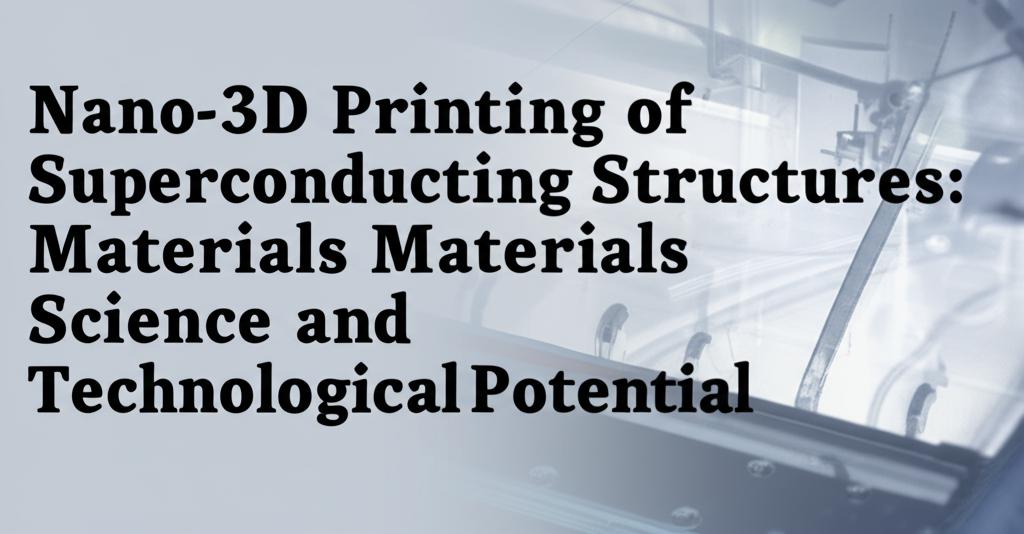The advent of nano-3D printing, also known as 3D nanoprinting, is pushing the boundaries of manufacturing, allowing for the creation of highly intricate structures at the nanoscale. This technological leap is particularly significant for superconducting materials, opening up new avenues for quantum devices, advanced medical imaging, and energy-efficient technologies.
Revolutionizing Superconductor FabricationTraditionally, fabricating superconducting materials, especially in complex three-dimensional (3D) geometries at the nanoscale, has been a major hurdle. Conventional methods like lithography are often limited to producing 1D and 2D structures, such as wires and thin films. However, recent breakthroughs are changing this landscape.
An international team, led by researchers at the Max Planck Institute for Chemical Physics of Solids, has recently pioneered a nano-3D printing technique capable of creating 3D superconducting nanostructures. This method offers unprecedented local control over the superconducting state within these tiny, complex architectures. For instance, these nanostructures can be switched on and off by simply rotating them in a magnetic field. This ability to create reconfigurable superconducting devices marks a significant step forward.
The transition from 2D to 3D at the nanoscale allows for the tailoring of material functionalities by introducing curvature, breaking symmetries, and creating interconnected channels. This is crucial for quantum materials, where patterning nanogeometries can directly alter the material's intrinsic properties.
Materials Science and Innovative TechniquesSeveral innovative approaches are being explored in the realm of nano-3D printing for superconductors:
- Focused Electron/Ion Beam Induced Deposition (FEBID/FIBID): These techniques utilize focused beams of electrons or ions to decompose precursor gases, depositing material with nanoscale precision. This method has been instrumental in creating complex 3D nano-superconductors, including nanohelices and hollow nanocylinders, with exceptionally high resolution.
- Two-Photon Polymerization (2PP): This laser-based technique allows for the creation of intricate polymer templates with submicron precision. These templates can then be coated or converted into superconducting materials. Researchers have successfully used 2PP to create high-aspect-ratio cavities that are subsequently metallized to form functional components.
- DNA Self-Assembly: In a novel approach, scientists have used DNA origami as a scaffold to build 3D nanoscale architectures. These DNA structures, with their inherent programmability, can be designed to form specific lattices and then coated with a superconducting material like niobium. The DNA template is subsequently removed, leaving behind a pure 3D superconducting nanostructure. This method offers a bottom-up approach to creating complex designs.
- Ink-Based 3D Printing and Single-Crystal Conversion: Researchers at Northwestern University and Fermi National Accelerator Laboratory have developed a two-step process for 3D printing high-temperature superconductors like Yttrium Barium Copper Oxide (YBCO). First, a specialized ink containing precursor powders is 3D printed into the desired complex shape. This polycrystalline structure is then sintered and subjected to a controlled heat treatment process (top-seeded melt growth) that converts it into a single-crystal superconductor. This method cleverly combines the design flexibility of 3D printing with the superior electrical properties of single-crystal materials, overcoming the brittleness and shaping limitations of traditionally grown single crystals. The resulting structures have shown significantly enhanced current-carrying capacity.
- Electrochemical Methods: Researchers are also exploring electrochemical techniques to create 3D metallic nanostructures with remarkable precision, reaching dimensions as small as 25 nanometers. These methods hold promise for applications in energy storage and microelectronics.
The ability to nano-3D print superconducting structures unlocks a vast range of technological possibilities:
- Quantum Computing and Sensing: Precisely engineered 3D superconducting nanostructures are crucial for developing advanced quantum bits (qubits), signal amplifiers, and highly sensitive magnetic field sensors. These components could significantly enhance the speed, accuracy, and stability of quantum computers and enable new frontiers in medical imaging (like MRI) and geological surveying.
- Advanced Particle Accelerators and Research Tools: High-temperature superconductors fabricated using 3D printing can lead to more powerful and efficient magnets for particle accelerators and other scientific instruments like synchrotron undulators and microwave cavities used in fundamental physics research.
- Energy Efficiency and Transportation: The development of more robust and complex superconducting components can contribute to low-loss power transmission and an D energy generation, as well as advancements in technologies like maglev trains.
- Miniaturized Electronics and Communication: Nano-3D printed superconducting components can be integrated into miniaturized RF devices, sensors, and communication systems, particularly relevant for 5G/6G technologies, the Internet of Things (IoT), and wearable electronics. The ability to create complex, high-aspect-ratio metal structures with sub-10 micron resolution opens new design freedoms.
- Reconfigurable and Adaptive Devices: The capability to locally control and even switch the superconducting state in different parts of a 3D nanostructure paves the way for adaptive or multi-purpose superconducting components. This could lead to complex superconducting logic and neuromorphic architectures, heralding a new generation of reconfigurable technologies.
Despite the exciting progress, challenges remain. Ensuring the material purity, structural integrity, and consistent superconducting properties of these nanoscale structures is critical. Further research is focused on refining fabrication processes, exploring new superconducting materials suitable for nano-3D printing, and developing robust characterization techniques for these 3D nanoarchitectures. The experimental validation of many theoretical predictions regarding the behavior of superconductors in complex 3D geometries is an ongoing effort.
In conclusion, nano-3D printing of superconducting structures represents a rapidly evolving field at the intersection of materials science, nanoscale engineering, and condensed matter physics. The ongoing innovations in printing techniques and material processing are paving the way for unprecedented control over the design and functionality of superconducting devices, promising transformative impacts across a multitude of technological domains.

